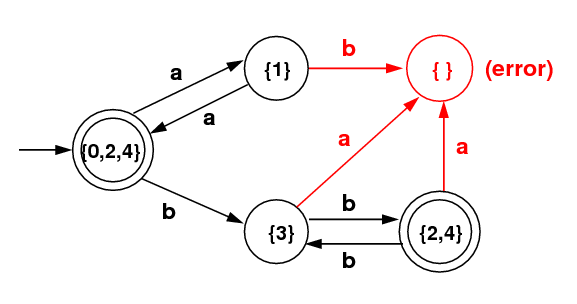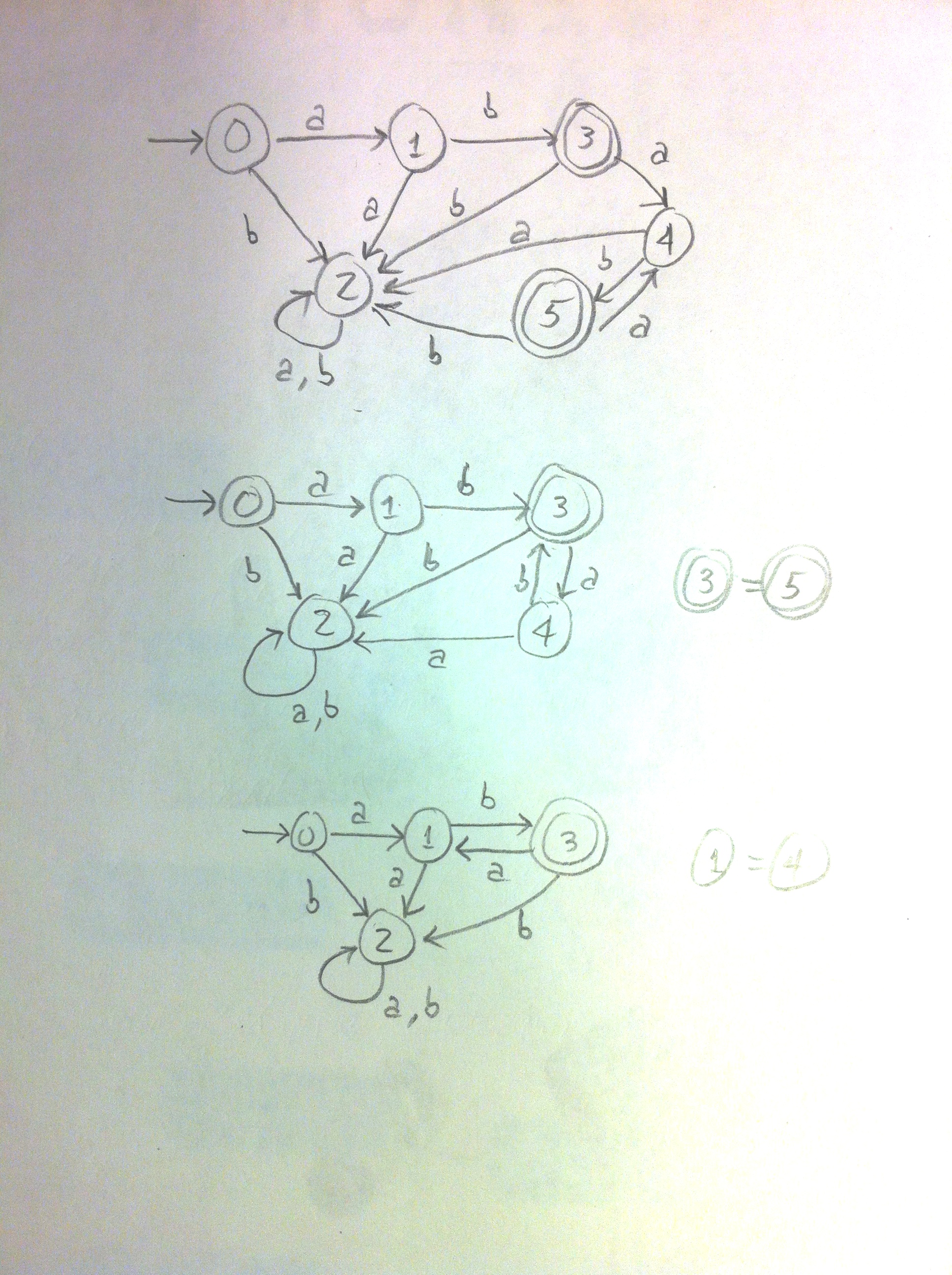|
CS 3723 Programming Languages Fall 2014 | |
Homework 4. NFAs with ε-moves
ANSWERS | ||
Week 4: Sep 15 - 19
| ||
Submit following directions at:
submissions
and rules at:
rules.
Deadlines are:
|
- Use the following NFA to represent the RE:
/(aa)*(bb)*/.
Carry out the extended subset algorithm on this NFA to get
a DFA that accepts the same language.
This isn't the only NFA that will work, but this is the one
you must work with.

State a b cl({0})={0,2,4} ST cl({1})={1} cl({3})={3} {1} cl({0})={0,2,4} { } {3} { } cl({2})={2,4} {2,4} T { } cl({3})={3} { } { } { } 
-
Suppose you want to handle the regular expression:
/ab(ab)*/.
The figure below gives this converted to an
NFA with ε-moves.
(Here "@" is what I use for ε in programs
(ε = the empty string).
This isn't the only NFA that will work, but this is the one
you must work with. (Below, the transition from state
7 to state 9 should be labeled with @.)

- Carry out the extended subset algorithm on this NFA to get a DFA that accepts the same language. [Your answer should have 6 states including the empty set as an error state.]
- This DFA is not optimal: it doesn't have the minimal number of states. But it can be converted to that optimal DFA by identifying two pairs of its states: the two terminal states (there are only 2), and two of the non-terminals. See if you can figure out what the minimal DFA is. (You haven't been given an algorithm for this.) Table and diagrams are below. The table may be a little confusing because each state is represented in two forms: as a subset of the original states, and as a number gotten from renumbering the states. The diagrams use the new numbering. Note that state 2 in the renumbering is the error state corresponding to the empty set.
State a b S 0 {0} 1 {1,2} 2 {} 1 {1,2} 2 {} 3 {3,4,8,9} 2 {} 2 {} 2 {} T 3 {3,4,8,9} 4 {5,6} 2 {} 4 {5,6} 2 {} 5 {4,7,9} T 5 {4,7,9} 4 {5,6} 2 {} 
- For this problem, you are to write another function p with one parameter n. This function must evaluate the same fraction, but must do it top-down, rather than bottom-up as before. You must use recursion and it must work for general n. The function cannot have a loop in it. Give results for p(10), p(15) and p(20). Below is a Python program that does this. There are two forms, the second more accurate than the first. The results are compared against the exact value of pi. Below the first program are two programs by students, the first elegantly simple and the second high-tech.
# pi_cf.py: pi from cont. fraction
import sys
import math
if len(sys.argv) != 2:
sys.stdout.write("Need 2 args\n")
else:
L = int(sys.argv[1])
def p1(i): # simple form
if i == L:
return 1
return (2.0*i-1)+(i*i)/p1(i+1)
def p2(i): # better approximation
if i == L:
return 2*L
return (2.0*i-1)+(i*i)/p2(i+1)
def p(n):
return 4.0/p2(n)
| sys.stdout.write("%3i, Pi: %19.16f, %19.16f\n" %
(L, math.pi, math.pi))
sys.stdout.write("%3i, Appr: %19.16f, %19.16f\n" %
(L, 4/p1(1), p(1)))
sys.stdout.write("%3i, Diff: %19.16f, %19.16f\n" %
(L, math.pi-4/p1(1), math.pi-p(1)))
|
# Recursive Continued fraction for pi
# Starter function to start evaluation of pi
def EvalFrac(n):
if(n == 0):
return 4
else:
return 4 / BottomFrac(1, n)
# Recursive function to calculate bottom part of the fraction
def BottomFrac(n, end):
if end == n:
return 2*n+1
else:
return (2*(n-1)+1) + ((n * n) / BottomFrac(n+1,end))
print(EvalFrac(10))
print(EvalFrac(15))
print(EvalFrac(20))
| |
#!/usr/bin/env python
from decimal import Decimal, ROUND_FLOOR, getcontext
def _pi(n, divisor):
'''Helper function. Carries around current n and divisor.'''
if n == 0:
return 4 / divisor
else:
return _pi(n - 1, (2 * (n - 1) + 1) + (n**2 / divisor))
def pi(n):
'''Calculates PI using continued fractions with n terms.'''
# Set the decimal precision and rounding.
getcontext().prec = int((n * 3) / 4.0)
getcontext().rounding = ROUND_FLOOR
return _pi(n, Decimal(2 * n + 1))
def main():
for x in range(5, 51, 5,):
print 'pi(%2s): %s' % (x, pi(x))
if __name__ == '__main__':
main()
| |
 Here is the internal representation of the above graph.
This information is not needed for this problem.
Here is the internal representation of the above graph.
This information is not needed for this problem.
| Graph (internal form) |
|---|
State Adjacency List 0 --> [a, 1] 1 --> [@, 5] 2 --> [b, 3] 3 --> [@, 5] 4 --> [@, 2] --> [@, 0] 5 --> [@, 9] 6 --> [c, 7] 7 --> [@, 9] 8 --> [@, 6] --> [@, 4] 9 --> [@, 8] --> [@,11] s 10 --> [@,11] --> [@, 8] t 11 --> |
| Graph (internal form) |
|---|
Auto: start: 10, term: 11 Total states: 12 abcab$ execNFA: execStr: abcab$ | 1 1 | 0 1 2 3 4 5 6 7 8 9 0 1 | - - - - - - - - - - - - : 0 0 0 0 0 0 0 0 0 0 1 0 s : 1 0 1 0 1 0 1 0 1 0 1 1 st a: 1 1 1 0 1 1 1 0 1 1 0 1 t |
-
- Verify that the Start State of the Simulated NFA is correct. (This is the next-to-the-last line, with "st" at the end.) [As an answer you can just do "mumble-mumble go from here to there", or better (but not required) show roughly how the depth-first search would proceed.]
- Verify that the last line is correct. This is the subset resulting from processing an input "a". (You must "show your work", meaning that you must give the set of states you find as being at the head of arrows labeled "a", and then show the result of the ε-closure.)
- Calculate the next two lines by hand, assuming the
further inputs (after the initial "a")
are "b" and then "c".
Give the resulting lines. (Again, in these two cases you must
"show your work" as above.)
Partial Answer to 4 RE: /(a|b|c)*/ RE (RPN form): ab|c|*$ Graph (internal form): 0 --> [a, 1] 1 --> [@, 5] 2 --> [b, 3] 3 --> [@, 5] 4 --> [@, 2] --> [@, 0] 5 --> [@, 9] 6 --> [c, 7] 7 --> [@, 9] 8 --> [@, 6] --> [@, 4] 9 --> [@, 8] --> [@,11] s 10 --> [@,11] --> [@, 8] t 11 -->
Auto: start: 10, term: 11 Total states: 12 Input string: abcab$ execNFA: execStr: abcab$, states: 100 | 1 1 | 0 1 2 3 4 5 6 7 8 9 0 1 | - - - - - - - - - - - - : 0 0 0 0 0 0 0 0 0 0 1 0 s : 1 0 1 0 1 0 1 0 1 0 1 1 st a: 1 1 1 0 1 1 1 0 1 1 0 1 t b: 1 0 1 1 1 1 1 0 1 1 0 1 t c: 1 0 1 0 1 0 1 1 1 1 0 1 t ------------------------------ (below not asked for) a: 1 1 1 0 1 1 1 0 1 1 0 1 t b: 1 0 1 1 1 1 1 0 1 1 0 1 t
